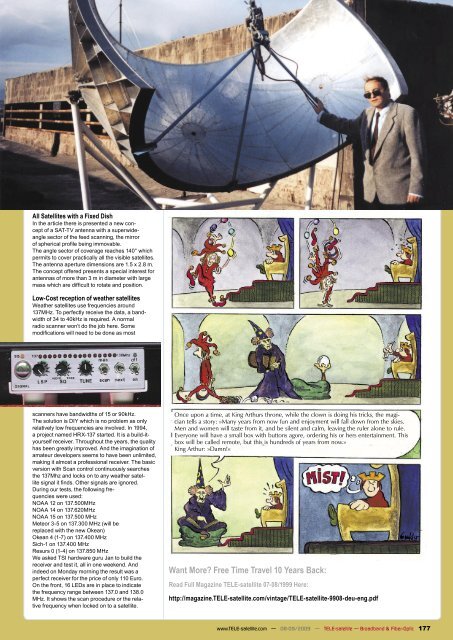08-09 - TELE-satellite International Magazine
08-09 - TELE-satellite International Magazine
08-09 - TELE-satellite International Magazine
You also want an ePaper? Increase the reach of your titles
YUMPU automatically turns print PDFs into web optimized ePapers that Google loves.
All Satellites with a Fixed Dish<br />
In the article there is presented a new concept<br />
of a SAT-TV antenna with a superwideangle<br />
sector of the feed scanning, the mirror<br />
of spherical profile being immovable.<br />
The angle sector of coverage reaches 140° which<br />
permits to cover practically all the visible <strong>satellite</strong>s.<br />
The antenna aperture dimensions are 1.5 x 2.8 m.<br />
The concept offered presents a special interest for<br />
antennas of more than 3 m in diameter with large<br />
mass which are difficult to rotate and position.<br />
Low-Cost reception of weather <strong>satellite</strong>s<br />
Weather <strong>satellite</strong>s use frequencies around<br />
137MHz. To perfectly receive the data, a bandwidth<br />
of 34 to 40kHz is required. A normal<br />
radio scanner won’t do the job here. Some<br />
modifications will need to be done as most<br />
scanners have bandwidths of 15 or 90kHz.<br />
The solution is DIY which is no problem as only<br />
relatively low frequencies are involved. In 1994,<br />
a project named HRX-137 started. It is a build-ityourself<br />
receiver. Throughout the years, the quality<br />
has been greatly improved. And the imagination of<br />
amateur developers seems to have been unlimited,<br />
making it almost a professional receiver. The basic<br />
version with Scan control continuously searches<br />
the 137Mhz and locks on to any weather <strong>satellite</strong><br />
signal it finds. Other signals are ignored.<br />
During our tests, the following frequencies<br />
were used:<br />
NOAA 12 on 137.500MHz<br />
NOAA 14 on 137.620MHz<br />
NOAA 15 on 137.500 MHz<br />
Meteor 3-5 on 137.300 MHz (will be<br />
replaced with the new Okean)<br />
Okean 4 (1-7) on 137.400 MHz<br />
Sich-1 on 137.400 MHz<br />
Resurs 0 (1-4) on 137.850 MHz<br />
We asked TSI hardware guru Jan to build the<br />
receiver and test it, all in one weekend. And<br />
indeed on Monday morning the result was a<br />
perfect receiver for the price of only 110 Euro.<br />
On the front, 16 LEDs are in place to indicate<br />
the frequency range between 137.0 and 138.0<br />
MHz. It shows the scan procedure or the relative<br />
frequency when locked on to a <strong>satellite</strong>.<br />
Once upon a time, at King Arthurs throne, while the clown is doing his tricks, the magician<br />
tells a story: »Many years from now fun and enjoyment will fall down from the skies.<br />
Men and women will taste from it, and be silent and calm, leaving the ruler alone to rule.<br />
Everyone will have a small box with buttons agore, ordering his or hers entertainment. This<br />
box will be called remote, but this is hundreds of years from now.»<br />
King Arthur: »Damn!«<br />
Want More? Free Time Travel 10 Years Back:<br />
Read Full <strong>Magazine</strong> <strong>TELE</strong>-<strong>satellite</strong> 07-<strong>08</strong>/1999 Here:<br />
http://magazine.<strong>TELE</strong>-<strong>satellite</strong>.com/vintage/<strong>TELE</strong>-<strong>satellite</strong>-99<strong>08</strong>-deu-eng.pdf<br />
www.<strong>TELE</strong>-<strong>satellite</strong>.com — <strong>08</strong>-<strong>09</strong>/20<strong>09</strong> — <strong>TELE</strong>-<strong>satellite</strong> — Broadband & Fiber-Optic 177

















